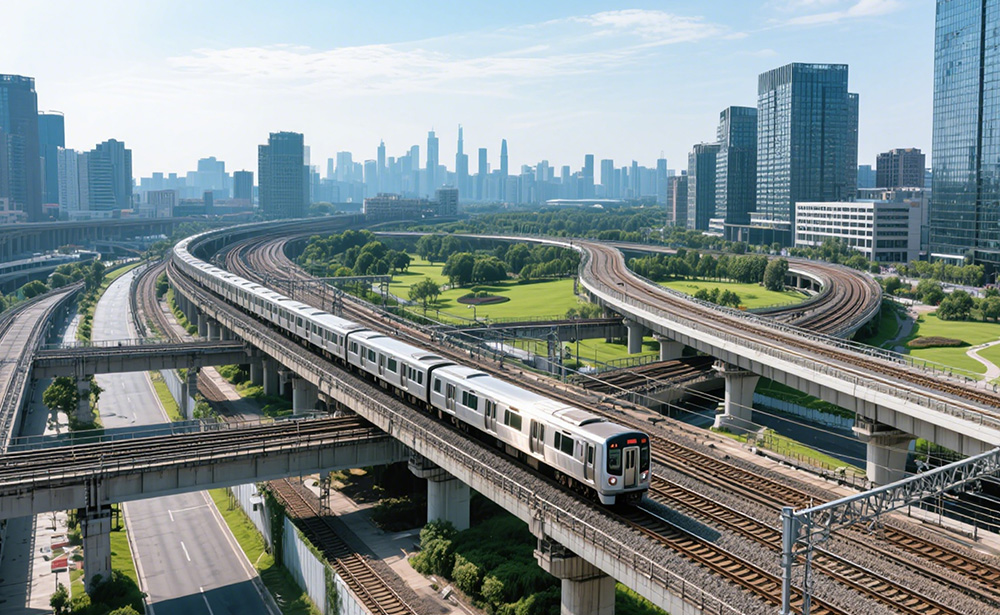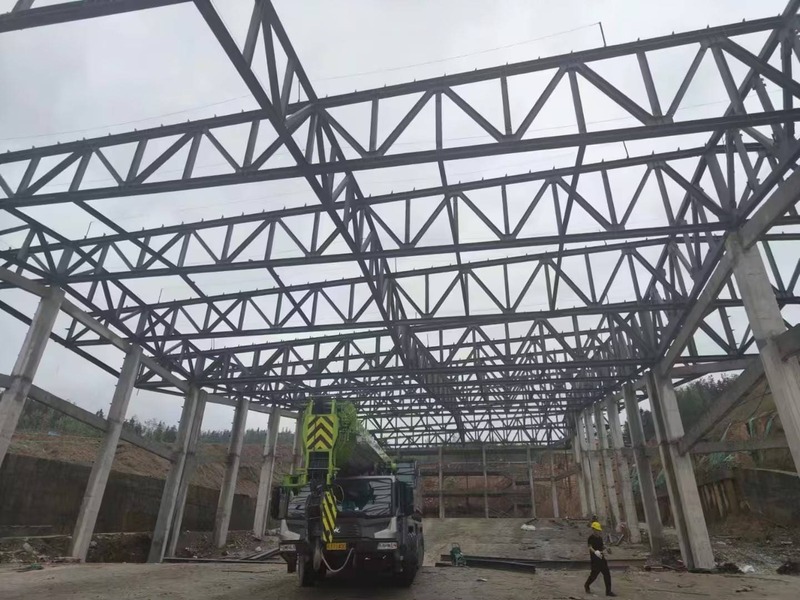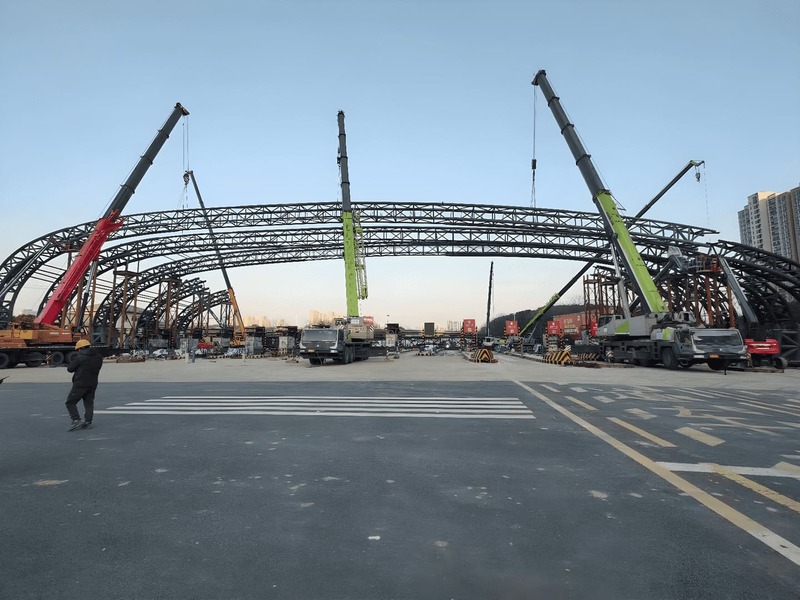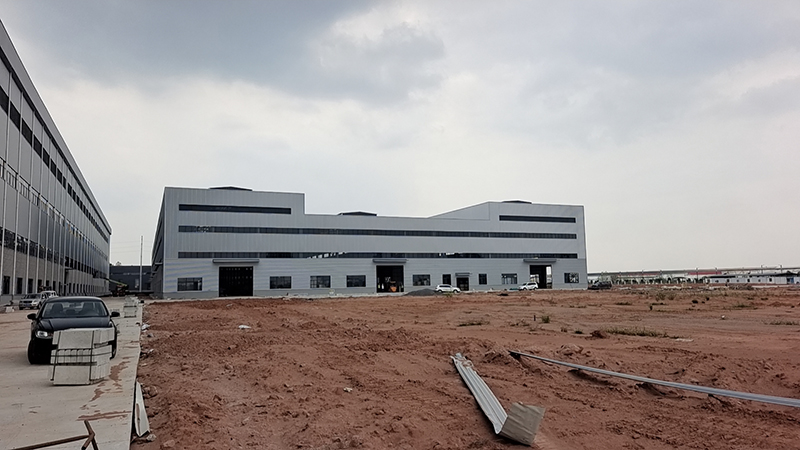1. Five major infrastructure solutions scenarios and steel structure adaptation solutions
Among the diverse demands of urban infrastructure solution construction, steel structure has become the key to solving the problem with its flexible adaptability. From skyscrapers 100 meters high to bridge projects across rivers and seas, XTD Steel Structure has developed special technical solutions for different scenarios.
- Odular emergency center: A quickly assembled steel structure building for disaster relief command or temporary medical treatment
- Dangerous building reinforcement: Steel structure solutions are often used for the safety renovation of existing public buildings.
- Multi-story parking garage: Rapid construction through modular steel structures can alleviate urban parking pressure.
- Educational and medical facilities: Schools, hospitals, and other buildings should be reinforced with steel structures, especially in areas with high earthquake intensity.
(I) Public Service Center: Steel-Concrete Multi-layer Structure
As urbanization accelerates, public service centers are gathering departments to facilitate citizens’ affairs, and the buildings where they are located are developing towards “higher, denser, and smarter”. The bottlenecks of traditional concrete structures in terms of construction period and space efficiency are becoming increasingly prominent. The steel-concrete multi-layer structure launched by XTD Steel Structure provides an efficient solution for the construction of the city skyline.
| Core parameters | Technical advantages | Owner Value |
| Structural form | Steel frame + concrete core | Resistant to 12-magnitude typhoons and 8-magnitude earthquakes, suitable for high-intensity development in urban core areas |
| Construction period | 20-storey main structure completed in 12 months | 50% shorter than traditional concrete, early investment, and early profit |
| Space efficiency | The vertical utilization rate increased by 300% | Can be integrated with office/commercial/parking, the first choice in the area where every inch of land is valuable |
| Typical Cases | A financial center building | The life cycle cost is reduced by 18%, and the standard floor area of 2,000 m2 is efficiently utilized. |
(II) Bridge Engineering: Spatial Truss Structure
As a key node in the transportation network, bridges need to take into account span, load, and durability. In coastal typhoon areas and inland earthquake zones, the spatial truss technology of XTD Steel Structure has become the preferred solution for the construction of cross-river and cross-sea bridges due to its advantages in wind and earthquake resistance.
| Technical highlights | Performance Data | Scene Adaptation |
| Single span | Max. 140 m | Main navigation channel other than the cross-river/cross-sea bridge |
| Load Capacity | 10kN/㎡ (6 lanes in both directions) | Heavy-load transportation hub bridge |
| Wind and earthquake resistance | 70m/s wind speed + 8 degree earthquake resistance | Coastal typhoon areas and earthquake-prone zones |
| Construction advantages | Prefabricated components were hoisted and installed in 45 days | The construction period is shortened by 40% compared with traditional methods, reducing traffic interruption time |
(III) Railway Station: Large-span Steel Truss
The advent of the high-speed rail era has put forward higher requirements on the carrying capacity and passenger flow organization of railway stations. The large-span steel truss solution of XTD Steel Structure not only meets the heavy-load demand but also optimizes the passenger travel efficiency through intelligent design, providing innovative ideas for the construction of hub railway stations.
| Functional design | Technical Parameters | Operational Value |
| Ground load | ≥5t/㎡ | Adapt to high-speed rail + baggage transport system |
| Waiting Space | Single span 120 meters without columns | Annual throughput of 20 million passengers, efficient diversion |
| Scalability | Modular interface | The platform extension was completed in 3 months, and the expansion was carried out while the station was in operation. |
| Intelligent Optimization | BIM pedestrian flow design | The walking time from the security check to the platform is ≤ 8 minutes, which improves the traffic efficiency. |
(IV) Subway lines and stations:
The rise of the steel-concrete composite structure TOD model has transformed subway stations into dynamic urban vitality hubs. This innovative infrastructure solution leverages the three-dimensional integration of above-ground and underground spaces, addressing the dual challenges of structural safety and construction speed.
| Three-dimensional transportation plan | Technical advantages | City Value |
| Top and bottom integrated | Underground platform + above-ground commercial | The subway complex was built in 60 days, activating the TOD model |
| Foundation Adaptation | Soft soil foundation treatment costs reduced by 50% | Coastal/alluvial plain areas preferred |
| Security System | Earthquake resistance level 8 + intelligent fire protection | Anti-progressive collapse design, 100% passed fire inspection |
| Traffic efficiency | Face recognition gate + smoke sensor linkage | Passenger flow rate increased by 40%, and emergency response was faster |
(V) Thermal power plant: ultra-heavy-load steel truss
In the field of industrial infrastructure solution, thermal power plants face complex environments such as high temperature, heavy load, and high corrosion, which place strict demands on structural materials and design standards. XTD Steel Structure‘s ultra-heavy-load steel truss technology achieves efficient equipment installation and long-term stable operation through customized solutions, becoming a reliable choice for industrial plant construction.
| Industrial-grade performance | Technical Parameters | Production guarantee |
| Equipment load | 10t/㎡ | Suitable for the installation of heavy equipment such as boilers/steam turbines |
| Heat resistant and anti-corrosion | 600℃ high temperature resistance + 50 years anti-corrosion coating | Coastal power plants/long-term stable operation in high temperature environments |
| Space efficiency | Column-free span 100 meters | Equipment installation efficiency increased by 60%, and maintenance channels became more spacious |
| Green Recycling | 90% of materials are recyclable | Recycling resources after decommissioning to reduce demolition pollution |
2. Steel structure VS traditional concrete: comparison of core performance of infrastructure
| Scene/Performance | Steel structure scheme | Traditional concrete solution | Differentiation |
| Bridge wind resistance | Can withstand a 17-level typhoon (70m/s) | 50m/s wind speed may cause cracking | Wind resistance increased by 40%, the first choice for coastal areas |
| Stadium construction | 90 days to complete the main construction | 240 days, 2.7 times longer | Shortened by 150 days, the event preparation cycle is more flexible |
| Subway station renovation | Modular disassembly and assembly, reducing transformation costs by 60% | Demolition and reconstruction, high cost and long cycle | Renovation while in operation, passenger flow impact <5% |
| Power plant corrosion protection | Coating + cathodic protection technology, 50 years without major maintenance | Anti-corrosion treatment is required every 10 years, and maintenance costs account for 20% | Reduce full-cycle maintenance costs by 75% |
| Earthquake resistance of high-rise buildings | Earthquake resistance of magnitude 8, deformation after the earthquake can be restored | Earthquake resistance ≤ 7, high-intensity areas need to be reinforced | Earthquake repair costs reduced by 80%, with better safety performance |
3. Key Materials and Technologies: Protecting Infrastructure Solution Quality
The quality assurance of infrastructure solution projects begins with material selection and technological innovation. How does XTD Steel Structure build a full-chain quality control system with its technological breakthroughs in the fields of load-bearing systems, enclosure systems, and intelligent safety?
(I) Comparison of core materials for load-bearing systems on Infrastructure solution
| Member | Steel structure scheme | Traditional concrete infrastructure solution | Performance Advantages |
| Steel Column | Q355B S355JR A572 SM490A high strength steel (compression resistance 345MPa) | Reinforced concrete column (compression resistance 25- 30MPa) | Strength increased by 45% and weight reduced by 60% |
| Core tube | C50 concrete + steel plate shear wall | Pure concrete core | Wind load resistance increased by 30%, and seismic ductility is better |
| Connection | High-strength bolts on-site assembly | Steel bar welding + concrete pouring | Construction error ±3mm, pollution reduction by 80% |
(II) Comparison of energy saving and noise reduction of enclosure systems
| Scenario | Steel structure scheme | Traditional Solution | Measured data |
| Bridge guardrail | Weathering steel + 320μm anti-corrosion coating | Concrete guardrail | Coastal lifespan 50 years (traditional 20 years) |
| Stadium roof | Double-layer corrugated steel plate + photovoltaic glass | Concrete roof | Annual electricity saving of 1.2 million kWh and sound insulation improvement of 25dB |
| Power plant exterior | Rock wool sandwich panel (sound insulation 65dB) | Ordinary brick wall | The factory noise is reduced by 40%, and the insulation efficiency is increased by 50%. |
4. Frequently Asked Questions
Q1. Is the initial cost of steel structure infrastructure solution higher than that of traditional concrete?
A: The initial cost of steel structure infrastructure solution is generally lower than that of traditional concrete. Although the main cost of steel structure may be about 10%-15% higher than that of traditional concrete, its light weight greatly reduces the cost of foundation treatment by 40%, especially in the construction of soft soil foundation, which can avoid the high cost of deep pile foundation. At the same time, the modular construction mode significantly reduces the on-site labor cost by 50%, greatly reducing the manpower expenditure during construction.
Q2. How to control the cost in remote areas or complex environments?
A: Plateau/mountainous areas: labor costs increase by 15%-20%, but factory prefabricated components reduce on-site operations. For example, a mountain bridge project shortened the total construction period by 3 months through prefabrication, and the total cost increased by only 5% after offsetting the transportation cost.
Coastal/corrosive environment: the cost of anti-corrosion coating increased by 5%, but the use of weathering steel + cathodic protection technology reduced the cost of anti-corrosion maintenance 3 times in 10 years (traditional concrete requires maintenance every 5 years), and the full cycle cost decreased by 10%.
Q3. How reliable is the steel structure for Infrastructure solution in extreme environments?
A: Adopting GB, EN, AISC design specifications, using Q355B S355JR A572 SM490A high-strength steel, it shows excellent performance. Its good ductility (elongation ≥ 20%), combined with shock-absorbing bearings, can absorb 30% of the seismic energy and reach the seismic resistance standard of level 8.
In the face of typhoons, the spatial truss structure design of the steel structure can withstand strong winds of 70m/s (level 17), and its stability has been verified by bridge wind tunnel experiments. For example, the main structure of the Zhuhai Airport Terminal remained intact after experiencing a level 12 typhoon, and the glass curtain wall was not damaged.
In high-temperature environments, special scenes such as thermal power plants will use 12Cr1MoV heat-resistant steel. Data shows that the steel can still maintain 60% of its strength at 600°C, while the strength of concrete drops by 50% at 200°C, highlighting the performance advantages of steel structures at high temperatures.
Q4. Can a steel structure shorten the construction infrastructure solution period? What is the actual effect?
A: Standardized construction: factory prefabrication rate ≥ 90%, on-site bolt assembly, 20-story public high-rise building completed in 12 months (traditional concrete takes 24 months), subway station completed the main structure in 60 days.
Typical case: A cross-river bridge uses space truss prefabrication technology, the main truss hoisting only 45 days (traditional concrete beams take 180 days), the overall construction period is advanced by 3 months, and the traffic control cost is reduced by 2 million yuan.
Q5. How to reduce the impact on the surrounding environment during construction?
A: Pollution control: welding operations are reduced by 80%, environmentally friendly anti-corrosion coatings are used (VOC emissions ≤ 50g/L), and construction waste is reduced by 85% compared with traditional processes.
Noise management: night construction noise ≤ 55dB (residential area standard), modular installation avoids high-noise processes such as concrete vibration.
Q6. Is it convenient to adjust or expand functions in the future?
A: Modular design: With reserved steel structure interfaces, the railway station platform can be extended within 3 months, and the gymnasium grid structure can complete functional zoning adjustment within 10 days (such as changing a badminton hall to a basketball hall).
Pipeline pre-buried: The removable ceiling hides 5G and smart equipment pipelines. The commercial floor of the subway station can be renovated without destroying the main structure, reducing the renovation cost by 60%.
5. Advantages of XTD Steel Structure and Infrastructure Solutions
| Core Advantages | Technical support | Customer Value |
| Full scene coverage | 7 major infrastructure solution types + 4 steel structure systems | One-stop solution for different needs, such as airports/bridges/power plants |
| Fast construction | Subway roof 60 days/power plant main building 120 days | 30% earlier than the industry average construction period, early production, and early profit |
| Green Infrastructure solution | 100% recycled steel + 57% lower carbon emissions | Assist with LEED / green building certification and enjoy policy subsidies |
Choose XTD Steel Structure – Powering Urban Infrastructure solution with a ‘Steel Engine’ for tougher bridges, smarter buildings, and more efficient energy solutions. Embark on a new era of infrastructure solution today, and join us in building a sustainable urban future!





